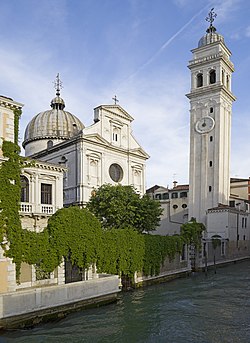Istituto Ellenico di Studi Bizantini e Postbizantini di Venezia

The Istituto Ellenico di Studi Bizantini e Postbizantini di Venezia ( Greek Ελληνικό Ινστιτούτο Βυζαντινών και Μεταβυζαντινών Σπουδών στη Βενετα , a Greek research institute founded in Venice and byzantine studies in Venice in 1953 and Greek center for research in Byzantine and byzantine Studies in Venice . It goes back to the Confraternità dei Greci Ortodossi di Venezia ( Brotherhood of Orthodox Greeks in Venice ) founded in 1498 and is maintained by the Republic of Greece . It is the only Greek research center abroad.
history
The foundation goes back to a cultural agreement of 1948 between Italy and Greece . In 1953 the Greek state gave the institute movable and immovable property that the Brotherhood of Orthodox Greeks had given it on condition that it guaranteed its continued existence. The institute began its work in 1958 and has since been housed in the Palazzo des Collegio Flanghini , which is part of the building complex around the Church of San Giorgio dei Greci .
The directors of the institute included Sophia Antoniadis (1955–1966), Manusos Manusakas (1966–1982), Nikolaos M. Panagiotakis (1989–1997), since 1998 Chrysa Maltezou has directed it.
tasks
The subject of research at the institute is Byzantine and post-Byzantine history, particularly with regard to the Greek territories under Italian rule and the publication of the relevant sources, but also with regard to the brotherhood of the Orthodox Greeks in Venice and their history. It is based on Italian and, in particular, Venetian archives. Greek PhD students and scholars are offered research grants to complete dissertations and other research in these fields.
Furnishing
The institute has a rich library, the basis of which is 41 Greek manuscripts, including three Gospel manuscripts on parchment from the 12th, 13th and 16th centuries and the famous manuscript of the Alexander novel by Pseudo-Callisthenes from the 14th century with 250 miniatures and around represent two thousand prints by Venetian-Greek printers from the 16th to the 18th centuries. Under the heading Γραφή και μικρογραφία στα χειρόγραφα του Ελληνικού Ινστιτούτου (12ος – 14ος αι.) ( Scripture and miniature painting in the manuscripts of the Greek Institute (12th – 14th) .
The institute also has a collection of icons presented in a museum .
Publications
The Institute is an annual journal Θησαυρίσματα and serials Biblioteca ( Βιβλιοθήκη τοῦ Ἑλληνικοῦ Ἰνστιτούτου Βενετίας Βυζαντινῶν καὶ Μεταβυζαντινῶν Σπουδῶν ), Oriens Graecolatinus , Graecolatinitas Nostra Fonti and Convegni out.
Web links
- Istituto Ellenico di Studi Bizantini e Postbizantini di Venezia (Homepage)
- Digitized archive of the institute (manuscripts, miniatures, certificates, prints, icons)
- Writing and miniature painting in the manuscripts of the Greek Institute (12th-14th centuries)
- Presentation on the website ( Memento of May 25, 2014 in the Internet Archive ) of the University of Venice
Coordinates: 45 ° 26 ′ 8 " N , 12 ° 20 ′ 41" E

